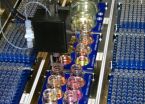To combat this "low fat is best" myth, nutrition experts at HSPH and chefs and registered dietitians at The Culinary Institute of America (CIA) have developed five new muffin recipes that incorporate healthy fats and whole grains, and use a lighter hand on the salt and sugar. Their goal? To "make over" the ubiquitous low-fat muffin, touted as a "better-for-you" choice when in fact low-fat muffins often have reduced amounts of heart-healthy fats, such as liquid plant oils, but boast plenty of harmful carbohydrates in the form of white flour and sugar.
Other low-fat processed foods are not much better, and are often higher in sugar, carbohydrates, or salt than their full-fat counterparts. For good health, type of fat matters more than amount. Diets high in heavily processed carbohydrates can lead to weight gain and an increased risk of type 2 diabetes and heart disease.
"It's time to end the low-fat myth," said Walter Willett, professor of epidemiology and nutrition and chair of the Department of Nutrition at HSPH. "Unfortunately, many well-motivated people have been led to believe that all fats are bad and that foods loaded with white flour and sugar are healthy choices. This has clearly contributed to the epidemic of diabetes we are experiencing and premature death for many. The lesson contained in these healthy muffins—that foods can be both tasty and good for you—can literally be life-saving."
A regular blueberry muffin from a national coffee shop chain has 450 calories on average and most of those calories come from carbohydrates, primarily white flour and sugar. However, now that national chains have eliminated trans fats, a regular muffin does have heart-healthy fat, usually from soybean or canola oil. A low-fat muffin has about the same amount of calories, but contains more carbohydrates and sugar—and about 60% more sodium (700 milligrams)—than a regular muffin.
The new Blueberry Muffin recipe offered by HSPH and the CIA is less than half the size of a coffee shop muffin and contains just 130 calories. It is made with a mixture of whole wheat, white, and almond flour and uses canola oil, a healthy fat. (See "Blueberry Muffin Battle" for a nutritional comparison of the three types of blueberry muffins: www.hsph.harvard.edu/nutritionsource/what-should-you-eat/blueberry-muffin-battle/index.html)
"There are so many ingredients available to home bakers who want to offer their families healthful, flavorful baked goods," says Richard Coppedge, Jr., chef-instructor at the CIA and a Certified Master Baker. "These five recipes not only include a wide variety of whole grain and nut flours; they also demonstrate how more unusual ingredients like canned chickpeas and extra virgin olive oil can be used in baking."
The CIA and HSPH offer a dozen healthy baking tips that professional chefs and home cooks can use to build a healthier muffin. Here are a few of their tips: Downsize the portions. The mega-muffins popular in bake shops are two to three times the size of the muffins your grandmother might have baked. Go whole on the grains. It's easy to substitute whole wheat flour for 50% of the white flour in recipes without harming taste or texture. And with a few recipe alterations, delicious muffins can be made with 100% whole grains. See the Lemon Chickpea Breakfast Muffin and the Whole Wheat Banana Nut Muffin recipes as examples. Slash the sugar. You can cut 25% of the sugar from most standard muffin recipes without any negative impact on flavor or texture, and in some recipes, cut back even more. Pour on the oil. Liquid plant oils—canola, extra virgin olive oil, corn, sunflower, and others—help keep whole-grain muffins moist and are a healthier choice than melted butter or shortening. Bring out the nuts. For extra protein and an additional source of healthy fats, add chopped nuts. Scale back the salt. The best way to reduce salt is to make a smaller muffin and to pair muffins with foods, such as vegetables and fruits, that are sodium-free. Pump up the produce—and flavor! Fresh whole fruit and unsweetened dried fruit naturally contain sugar, but unlike other sweeteners, they also contain fiber and important nutrients. Using fruit in your muffins means you can have a lighter hand on the added sugar. Cooked or raw vegetables, such as caramelized onions, sliced jalapeños, and chives and other fresh herbs—together with a whole range of spices—can add interesting textures and savory flavors to muffins.
The muffin recipes and photos, baking tips, a Q & A on why it's time to end the low-fat myth, and a handy chart showing how to find foods with healthy fats are all available on The Nutrition Source, a nutrition website from the Harvard School of Public Health: www.hsph.harvard.edu/nutritionsource/what-should-you-eat/muffin-makeover/index.html
"We need to make healthy fats and whole grains the new baking norm, at home and in the professional kitchen," says Greg Drescher, Vice President of Industry Leadership and Strategic Initiatives for the CIA. "We call on restaurants and other food service providers to be leaders in promoting healthy fats—and in doing away with the low-fat myth."
INFORMATION:
About Harvard School of Public Health
Harvard School of Public Health is dedicated to advancing the public's health through learning, discovery and communication. More than 400 faculty members are engaged in teaching and training the 1,000-plus student body in a broad spectrum of disciplines crucial to the health and well being of individuals and populations around the world. Programs and projects range from the molecular biology of AIDS vaccines to the epidemiology of cancer; from risk analysis to violence prevention; from maternal and children's health to quality of care measurement; from health care management to international health and human rights. For more information on the school visit www.hsph.harvard.edu.
HSPH on Twitter: http://twitter.com/HarvardHSPH
HSPH on Facebook: http://www.facebook.com/harvardpublichealth
HSPH on YouTube: http://www.youtube.com/user/HarvardPublicHealth
HSPH home page: http://www.hsph.harvard.edu
About The Culinary Institute of America
Founded in 1946, The Culinary Institute of America is an independent, not-for-profit college offering bachelor's and associate degrees in culinary arts and baking and pastry arts as well as certificate programs in culinary arts, Latin cuisines, and wine and beverage studies. As the world's premier culinary college, the CIA provides thought leadership in the areas of health & wellness, sustainability, and world cuisines & cultures through research and conferences. The CIA has a network of more than 44,000 alumni that includes industry leaders such as Grant Achatz, Anthony Bourdain, Cat Cora, Dan Coudreaut, Steve Ells, Roy Choi, Johnny Iuzzini, Charlie Palmer, and Roy Yamaguchi. In addition to its degree programs, the CIA offers courses for professionals and enthusiasts, as well as consulting services in support of innovation for the foodservice and hospitality industry. The college has campuses in Hyde Park, NY; St. Helena, CA; San Antonio, TX; and Singapore. For more information, visit the CIA online at www.ciachef.edu.
See recipes for Blueberry Muffins, Cranberry Orange Muffins, Jalapeño Cheddar Corn Muffins, Lemon Chickpea Breakfast Muffins, and Whole Wheat Banana Nut Muffins: www.hsph.harvard.edu/nutritionsource/what-should-you-eat/muffin-makeover/index.html
END


